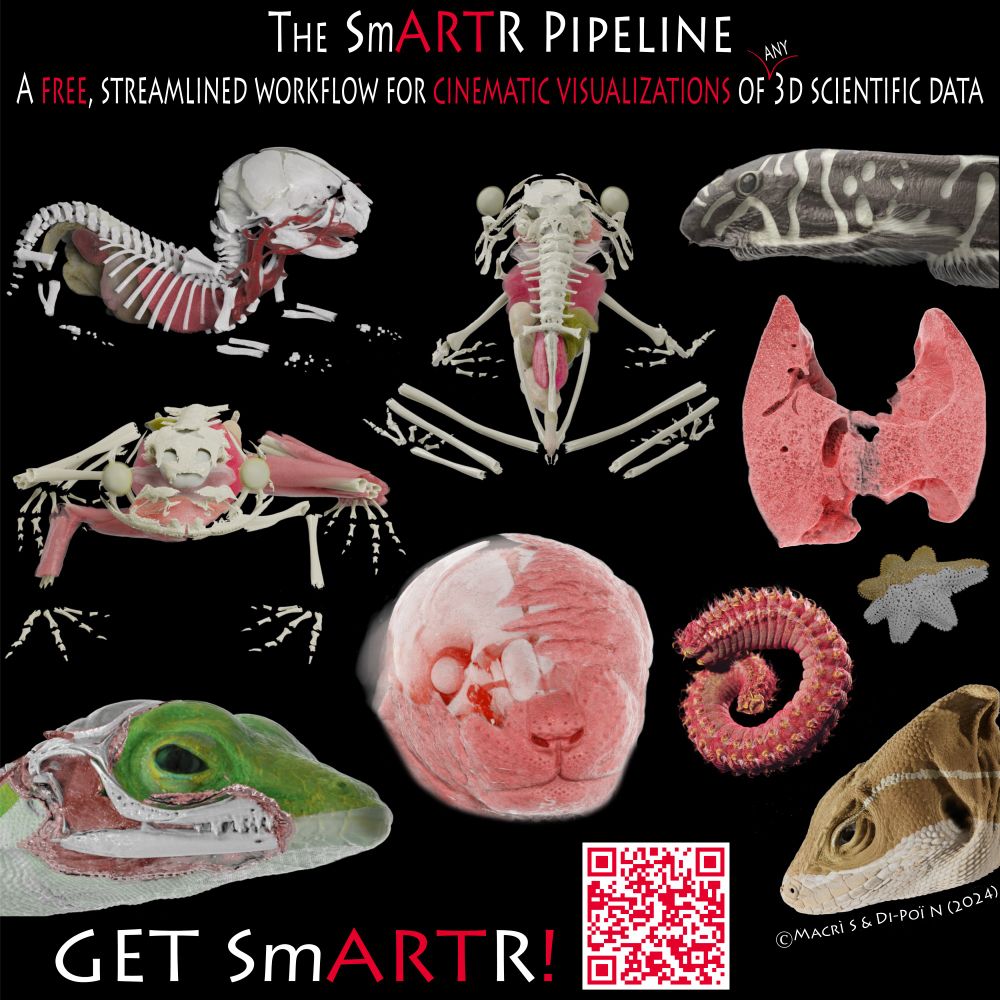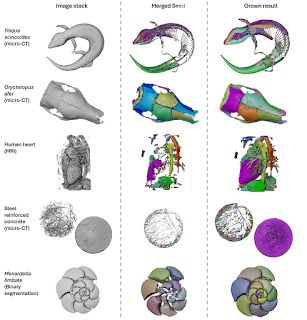My new book is out!
📖 Exploring the Evolution of Our Ancestors: On the Human Track 🌍
It shows how diet, brains, locomotion & skin shaped our bodies through evolution—written for both students & curious readers.
👉 Routledge, Amazon, Indigo, Barnes & Noble, ...
@crcpressphysics.bsky.social
19.08.2025 09:33 — 👍 1 🔁 0 💬 0 📌 0

Danial Forouhar (from @dadriaens.bsky.social lab) had amazing 3D images of the muscluoskeletal system of seahorse tails, which opened lots of exciting questions about how these body muscles actuate tail prehension.
01.08.2025 07:38 — 👍 3 🔁 2 💬 1 📌 0
Soon my book on human evolution will be available in English, published by CRC Press. Will keep you posted on the release date. With special thanks to Charles R. Crumly for making this possible.
17.07.2025 21:01 — 👍 1 🔁 0 💬 0 📌 0

A short-snouted seahorse on knotted wrack (algae). The seahorse is brown and it's holding onto the wrack by its tail. Photo by Hans Hillewaert.

The rendering of the scanned seahorse tail, showing the armored plates surrounding the vertebrae, with four interlocking plate elements constituting a section of the tail shown in different colours. Below, some theoretical models of the tail for simulation purposes.
#CTpost #3 🩻🐎🐟
The tail of a seahorse has a square section ⏹️, it's prehensile and covered in armored plates. If you #µCT scan it (rendering in right image), you'll see the plates interlock around the vertebrae. But why a square? (1/2) 🧪 #science #fish
www.science.org/doi/abs/10.1...
08.01.2025 08:15 — 👍 23 🔁 2 💬 2 📌 0

Do you use 3D imaging like CT or MRI for research, teaching, outreach, or art? Check out our new article featuring a detailed workflow for producing 3D cinematic renderings―from tissue-level to whole-organism details―with stunning realism! doi.org/10.1016/j.is... @helsinkiuni.bsky.social
23.11.2024 12:27 — 👍 88 🔁 23 💬 6 📌 1

Figure showing diverse datasets analysed with SPROUT, including a skink skeleton, aardvark skull, human heart, concrete block, and foraminifera.
New paper! For all of you working with 3d scans (e.g. micro-CT, MRI), check out SPROUT, a rapid open-source tool for generating segmented and parcellated data, meaning your scans are separated into the individual elements without any manual labelling or training. www.biorxiv.org/content/10.1...
24.11.2024 13:09 — 👍 213 🔁 92 💬 10 📌 6
Muscle physiologist interested in bridging the gap between experiments and theory to understand dynamic muscle function
Assoc. Editor, Life Sciences De Gruyter Brill. Promoting articles on behavior (Behaviour, Folia Primatologica, Amphibia-Reptilia, Animal Biology, Contributions to Zoology) & perception (Multisensory Research, Timing & Time Perception, Art & Perception).
Senior lecturer (Assoc. Prof.) at University of Liverpool, Evolutionary Morphology & Biomechanics (EMB) research group 💀Mostly cranial form & function in mammals 🐇🐀🦇🐒🦍🐘🦒🦬🦏
🔗 @livevobiomech.bsky.social
Northern Arizona University, Department of Biological Sciences
Biomechanics, Physiology, Feeding, Locomotion
Mayerllab.com
Scientific illustrator and wildlife artist.
Former scientist - biologist
Commissions: lazaroillustration@gmail.com
Prints store: https://www.inprnt.com/gallery/javi_lazaro/
Web: https://www.lazaroillustration.com/
Human artist. No AI art.
PhD Student in Diapsid Skull Evolution at the University of Lincoln.
Professor of palaeontology @ Université de Liège, Belgium
Director of the Evolution & Diversity Dynamics Lab. I study the biodiversity and extinctions of fossil marine predators
SICB Divisions of Comparative Biomechanics and Vertebrate Morphology
Account run by DVM & DC’s SPDAC Representatives @emily-mcparland.bsky.social & @melodyoungg.bsky.social
Instagram: @sicb.dvm.dcb
PhD candidate at the EvoMorph Lab, Monash University, researching beak evolution and development.
Researcher, anatomist and animal enthusiast
Researcher, nature artist, & science writer with a focus on birds.
University of Antwerp 🇧🇪
I write 'Beaks & Bones,' a newsletter on bird science.
https://beaksandbones.substack.com
Contact: https://maja.mielke.ws/contact/
🇩🇪 in 🇧🇪
she/her
Functional Morphology Lab Group of Department of Biology, University of Antwerp.
https://www.uantwerpen.be/en/research-groups/funmorph/
Preserving the digital heritage of life on earth.
Scientific illustration, Figure Design, Logo Creation, and Web Design
We transform discoveries into artistic masterpieces #SciArt
✉️ contact@drawimpacts.com
Prof of Biomedical Engineering @uclmecheng interested in #biomechanics #bones #joints #craniosynostosis #medicaldevices #publicengagement #craniofacial system
Zoologist | Animal physiology and biomechanics | Wilding | Science communicator for Duchenne MD
Views are based on whatever I watched
recently and passed off as my own
Founder & Biofuturist @ Biomimicry Innovation Lab
Come say hello - https://hihello.me/hi/richardjamesmaccowan-ZRKBMg
Marine biologist at the University of Southampton. Researching reef fish ecology and evolution and the awesomest fish in the sea - gobies. 🐠🪸🇬🇧🇪🇺🇭🇲🏳️🌈
Professor in EEOB at UC Riverside 🇨🇦 & 🇺🇸
Comparative Biomechanics 🏃🏻♂️ | Ecomechanics 🌲 | Functional Morphology 🦴 | Comparative Physiology 💪 | Adhesion | Herpetology 🦎🐍 | Icththyology 🐟 🐡🦈|









